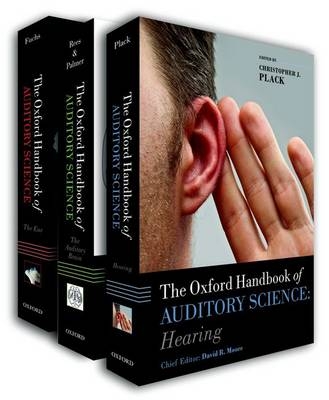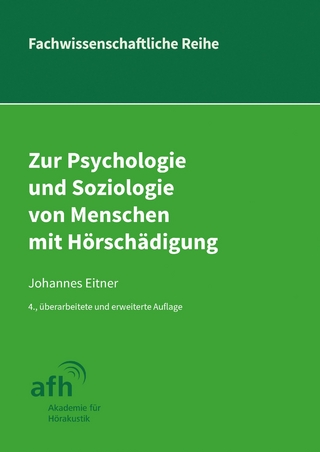
Oxford Handbook of Auditory Science
Seiten
2010
Oxford University Press (Verlag)
978-0-19-958141-2 (ISBN)
Oxford University Press (Verlag)
978-0-19-958141-2 (ISBN)
- Titel ist leider vergriffen;
keine Neuauflage - Artikel merken
Volume 1: The Ear (edited by Paul Fuchs) Volume 2: The Auditory Brain (edited by Alan Palmer and Adrian Rees) Volume 3: Hearing (edited by Chris Plack) Auditory science is one of the fastest growing areas of biomedical research. There are now around 10,000 researchers in auditory science, and ten times that number working in allied professions. This growth is attributable to several major developments: Research on the inner ear has shown that elaborate systems of mechanical, transduction and neural processes serve to improve sensitivity, sharpen frequency tuning, and modulate response of the ear to sound. Most recently, the molecular machinery underlying these phenomena has been explored and described in detail. The development, maintenance, and repair of the ear are also subjects of contemporary interest at the molecular level, as is the genetics of hearing disorders due to cochlear malfunctions. The auditory brain has now been shown to consist of much more than the regions of the classical 'central auditory system'.
Through fMRI studies in humans and the application of novel methods in animal research, the cortical areas involved in hearing and listening in primates have been found to extend beyond the superior temporal plane into more rostral and ventral regions of the temporal cortex, and into parietal and frontal lobes. At the same time, our understanding of subcortical and core cortical areas has expanded through the use of spectrally complex stimuli and multi-channel recordings, increasingly in awake, behaving animals. Studies of auditory perception have increasingly focused on auditory 'ecology', on complex sound perception in real (or virtual) environments. Traditional distinctions between spectral, temporal and binaural processing have evolved into more functional concerns, with speech, pitch, spatial hearing and auditory object perception. Dynamic properties of hearing are becoming more prominent as adaptation and learning receive increasing recognition.
Finally, influences of hearing on and by cognition (attention, memory and emotion), action and vision add to a picture of a powerful, working, integrated sense that is, arguably, the most important contributor to our interaction with our world. With each volume dedicated to one these core topics, The Oxford Handbook of Auditory Science is a major publication in the field. It brings together the views of leading researchers in the field to provide a comprehensive and authoritative review of the current state of the art in auditory science. The breadth of coverage, coupled with the accessibility of the short chapter format will make the handbook essential reading for both students and researchers in the field of audition, as well as those in psychology and neuroscience. Clinical audiologists and otolaryngologists will also find this handbook an indispensable reference source.
Through fMRI studies in humans and the application of novel methods in animal research, the cortical areas involved in hearing and listening in primates have been found to extend beyond the superior temporal plane into more rostral and ventral regions of the temporal cortex, and into parietal and frontal lobes. At the same time, our understanding of subcortical and core cortical areas has expanded through the use of spectrally complex stimuli and multi-channel recordings, increasingly in awake, behaving animals. Studies of auditory perception have increasingly focused on auditory 'ecology', on complex sound perception in real (or virtual) environments. Traditional distinctions between spectral, temporal and binaural processing have evolved into more functional concerns, with speech, pitch, spatial hearing and auditory object perception. Dynamic properties of hearing are becoming more prominent as adaptation and learning receive increasing recognition.
Finally, influences of hearing on and by cognition (attention, memory and emotion), action and vision add to a picture of a powerful, working, integrated sense that is, arguably, the most important contributor to our interaction with our world. With each volume dedicated to one these core topics, The Oxford Handbook of Auditory Science is a major publication in the field. It brings together the views of leading researchers in the field to provide a comprehensive and authoritative review of the current state of the art in auditory science. The breadth of coverage, coupled with the accessibility of the short chapter format will make the handbook essential reading for both students and researchers in the field of audition, as well as those in psychology and neuroscience. Clinical audiologists and otolaryngologists will also find this handbook an indispensable reference source.
See individual volumes
| Erscheint lt. Verlag | 14.1.2010 |
|---|---|
| Verlagsort | Oxford |
| Sprache | englisch |
| Maße | 181 x 255 mm |
| Gewicht | 3223 g |
| Themenwelt | Medizin / Pharmazie ► Medizinische Fachgebiete ► HNO-Heilkunde |
| ISBN-10 | 0-19-958141-X / 019958141X |
| ISBN-13 | 978-0-19-958141-2 / 9780199581412 |
| Zustand | Neuware |
| Haben Sie eine Frage zum Produkt? |
Mehr entdecken
aus dem Bereich
aus dem Bereich
ein Kompendium von Praktikern für Praktiker
Buch (2023)
Thieme (Verlag)
CHF 459,95
Differenzierte Diagnostik und Therapie
Buch | Hardcover (2021)
Springer (Verlag)
CHF 249,95
Buch | Softcover (2022)
Median-Verlag von Killisch-Horn GmbH
CHF 74,20


